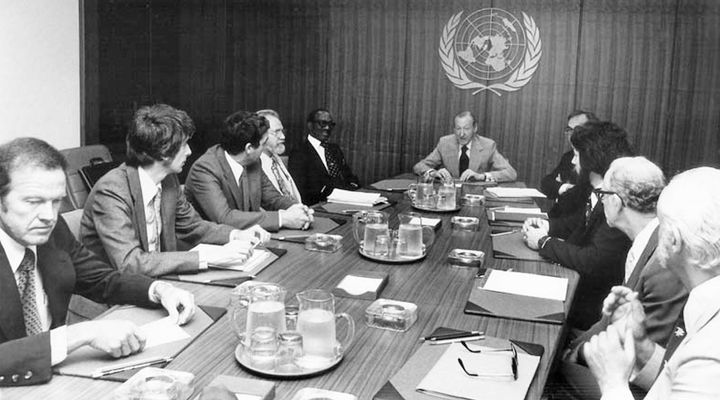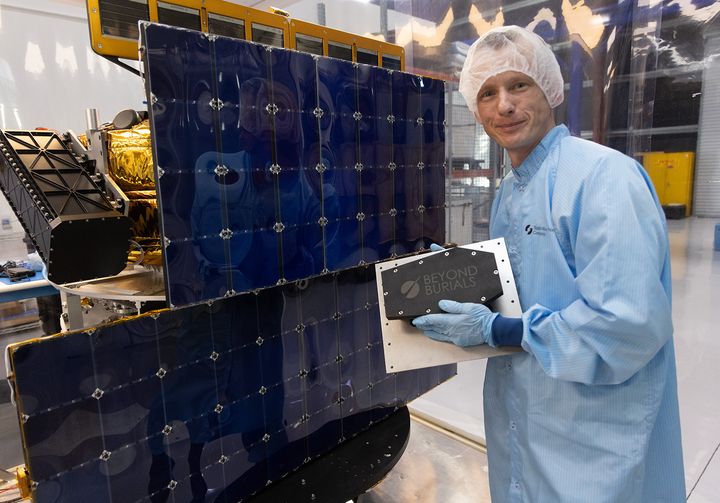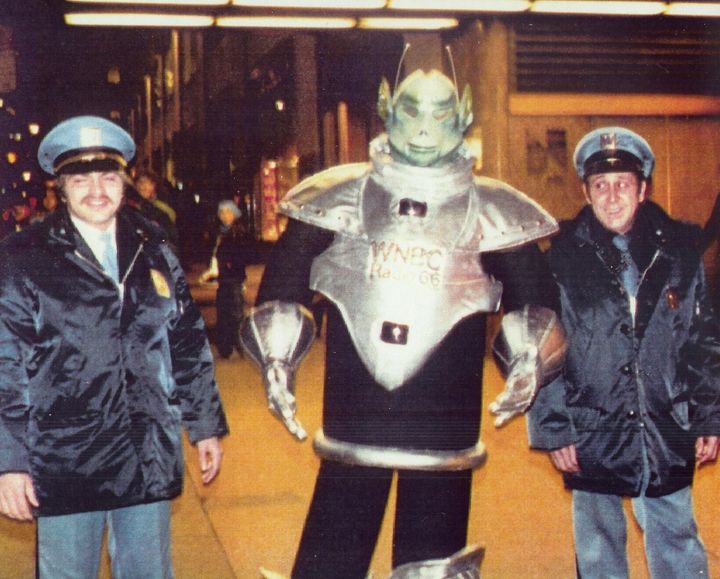Famed UFO Reporter Puts Skeptics On Blast With A Defiant Final Act
When Lee Speigel arrived in New York City in the early 1970s, there was a word for people who reported seeing a UFO ― “kooks.”
The world this 74-year-old man left behind on Aug. 14, after a battle with esophageal cancer, has vastly changed. Politicians, scientists and law enforcement officials are no longer laughing at those who say they’ve witnessed an unexplained phenomenon.
Advertisement
Just weeks before Speigel’s death, military whistleblowers testified before a congressional committee, claiming the government has secretly retrieved and reverse-engineered unidentified flying objects. And though the Pentagon denied those claims, it soon unveiled a website devoted to sightings of unidentified flying objects.
As 2023 drew to a close, Congress ordered all files on UFOs ― now classified as unidentified anomalous phenomena (UAPs) ― released within 25 years so long as there was no Oval Office objection. These are files that government officials barely acknowledged in years past ― and information Speigel and other UFO investigators spent their lives in search of.
NASA still maintains that there’s no proof UFOs are the work of extraterrestrials, but it’s a conversation that can no longer be ignored.
To be sure, no single person can take credit for shifting public opinion, but Speigel’s contributions over his 60-year career stand out. He is renowned as the first person to organize and host a conference at the United Nations on UFOs, attended by dignitaries from around the world.
Advertisement
“Lee sought out interviews with military officers, commercial airline pilots and the best sources he could find. These people put their credibility on the line when they claimed they saw something in the sky that defied explanation,” said Buck Wolf, director of HuffPost Trends, who also worked with Speigel at ABC News.

Courtesy of Lorraine Simone
“Lee might be the only UFO writer and researcher from his generation to make the jump into mainstream journalism. At NBC Radio, ABC News and HuffPost, his colleagues looked at him with skepticism and amusement. But he also earned their respect,” Wolf said.
Rocketing Into Space At 17,500 MPH
Wolf and Speigel’s widow, Lorraine Simone, raised more than $10,000 from friends, family and admirers for one final tribute — to send Speigel’s cremated ashes into space. His remains will be loaded on a SpaceX Falcon 9 rocket, scheduled for launch on March 4 at Vandenberg Space Force Base in Southern California.
Speigel’s ashes will circle the Earth every 90 minutes at roughly 17,000 to 17,500 miles per hour on a mission slated to last two to three years and will burn up upon reentry, “like a shooting star,” said Dan Peabody, CEO of Beyond Burials, the company administering Speigel’s funeral service.
Advertisement
“Star Trek” creator Gene Roddenberry, along with original cast members James Doohan and Nichelle Nichols; noted astronomer Clyde Tombaugh, best known for discovering Pluto; and 1960s counterculture hero Timothy Leary are among those who have also had space funerals.
“Anyone who knew Lee knows he wanted to get into space somehow, especially after William Shatner did it,” said Simone. “I’m sure Lee is somewhere enjoying all this immensely.”
Shatner, who portrayed the legendary Capt. Kirk on “Star Trek,” was 90 when he became the oldest man to voyage to space on a 2021 Blue Origin launch.

Courtesy of Beyond Burials
In addition to the space funeral, Speigel’s friends and family organized and shipped his massive archive of taped interviews and case files to the National UFO Historical Records Center in Rio Rancho, New Mexico.
Advertisement
Cmdr. Allan Palmer, a retired Air Force and Navy combat aviator, now serves as CEO and executive director at the National Atomic Testing Museum in Las Vegas. He thinks Speigel’s work is worthy of further study.
Palmer consulted with Speigel in 2013 when creating the museum’s Area 51 exhibit. Area 51 is the now-famous top-secret site set up by the CIA and Air Force in 1955, which looms large in UFO lore.
In the 1950s and 1960s, if a commercial pilot saw an aircraft flying at 70,000 feet or traveling at three times the speed of sound, it certainly would have seemed like otherworldly technology, Palmer said. Yet it wasn’t until 2013 that the government started acknowledging what was going on there.
“Lee did so much in telling the story responsibly,” Palmer said. “Yet even with all we know today, there are still many unanswered mysteries.”
From ‘Happy Day’ To ‘Flying Doritos’
Speigel’s personal journey is almost as amazing as some of the stories he covered.
As a teen in Concord, New Hampshire, in the late 1960s, Elliot “Lee” Speigel was obsessed with the Apollo space program. But it was his other childhood love that brought him to New York City: folk music.
Advertisement
By the early 1970s, he was singing and playing guitar on the same Greenwich Village stages that Bob Dylan and Harry Belafonte had been performing on a few years earlier. He went by the stage name Happy Day.
Like any aspiring musician in the big city, Speigel scrambled to pay bills, working at times as a waiter, bartender and NBC page. He also put his tenor voice and audio production skills to use, crafting radio station ads and commercial jingles.
In his downtime, Speigel devoured everything he could find on UFOs, but, except for sci-fi camp, all he could find were stray news clippings and paperback books. It struck him that there were no solid, feature-length recordings of some of the most credible UFO witnesses. He was soon pitching himself as the guy with the audio production skills to put that project together.

Courtesy of Lorraine Simone
By 1975, Speigel was traveling the country, conducting interviews that would become the CBS documentary record album “UFOs: The Credibility Factor,” featuring scientists, military personnel and aviation experts who admitted seeing things that defied explanation. Speigel focused extensively on the notorious July 1947 incident in Roswell, New Mexico, when the military seemed to admit — and then abruptly deny — that it had recovered the debris of an aircraft “not of this Earth.”
Advertisement
In one of Speigel’s field assignments, astronomer J. Allen Hynek, a scientific adviser to the Air Force’s UFO study, Project Blue Book, invited him to North Carolina to investigate what the UFO website Rogue Planet described as “a spate of UFO sightings observed by local law enforcement.”
During the trip, Speigel and multiple officers saw what he described as “the first well-documented UFO incident in the U.S. involving a triangle or boomerang-shaped UFO and multiple witnesses.”
Speigel would joke years later that what they saw in the sky that day resembled “flying Doritos.”
Rise Of The Reptile Space Alien
Speigel was hawking his UFO audio documentary album on late-night TV commercials in 1978 when he was invited by the island nation of Grenada to organize a meeting at the United Nations, attended by dignitaries from around the world, including U.N. Secretary-General Kurt Waldheim.
“Lee made a major contribution by organizing the U.N. meeting, which he is so well known for,” said Leslie Kean, author of the 2011 New York Times bestseller “UFOs: Generals, Pilots, and Government Officials Go on the Record” and co-author of a 2017 New York Times investigative piece that revealed a secret Pentagon project to study UFOs.
“He was one of the few reporters who had a platform to do regular stories on UFOs and related topics,” Kean said.
Advertisement
By the late 1970s, Speigel’s work caught the eye of future MTV CEO Bob Pittman. In one of the most memorable nights of his life, they attended a party with comedian Richard Belzer. Together, they conceived of the late-night NBC Radio show “Edge of Reality,” hosted by Speigel, though at first he was billed only as “The Alien,” for promotional purposes.
“There has always been huge interest in UFOs ― but not much info or ongoing dialogue, even more so way back then,” Pittman told HuffPost by email. “This was an attempt to tap into that for our audience.”

Courtesy of Lorraine Simone
Speigel dressed as a super-sized space lizard at promotional events to the delight of fans around New York City. If his shiny spacesuit looked a bit familiar, it’s because it was designed by the same NBC wardrobe team that threw together “Saturday Night Live’s” Conehead costumes.
“It started as a gimmick, hence the name and suit. But [it] morphed into more serious reporting with Lee as the expert,” Pittman explained.
Advertisement
“Did it change my views? Not sure, but it sure got me more interested,” said Pittman, adding that he thought Speigel was “a great human” who was “nice, considerate and thoughtful, as well as fun and funny.”
Howard Stern vs. Lee Speigel
Speigel shared an NBC studio briefly with notorious shock jock Howard Stern, who would occasionally go off on his otherworldly colleague.
“He’d have people on from Mars,” Stern recalled in a hilarious 1992 on-air rant. “It was always UFOs. Every week. It’d be a whole show on UFOs. … I’d say to him, ‘Have you seen a UFO?’” Stern denied that Speigel ever gave him a satisfactory answer.
In an eight-year period beginning in 1978, Speigel recorded roughly 1,500 hours of local and national programming, interviewing actors William Shatner and Leonard Nimoy, astronomers, astronauts and others who had something to say about the search for intelligent life in the universe.
In that time, when Stephen Spielberg was working on projects like “Close Encounters of the Third Kind” and “E.T. the Extra Terrestrial,” Spielberg had Speigel flown out to his home.
Advertisement
“Lee had his share of celebrity fans. Robin Leach would visit when Lee he was in New York, not to discuss lifestyles of the rich and famous, but to go UFO hunting,” Wolf said. “One time, Lee invited a few of us HuffPosters to go see ZZ Top, and it was because the band wanted Lee to stay after the show and talk about space aliens.”
When “Edge of Reality” ended, Speigel remained at NBC Radio in New York working on science and human interest stories while also contributing to Omni magazine. He joined ABC Radio Networks in the late 1990s, eventually moving to ABCNews.com as a copy editor.
In 2010, when Wolf offered Speigel a chance to write freelance articles on unexplained phenomena for AOL News, he quit ABC, even though that meant giving up his health insurance. He was eventually brought on to The Huffington Post (now HuffPost) as a full-time reporter, winning the 2012 International UFO Congress Researcher of the Year award.

Damon Scheleur/HuffPost
In his six years at The Huffington Post, Speigel was able to get astronauts Edgar Mitchell, Alan Bean and Leroy Chiao to go on the record about UFOs, as well as luminaries, like actor Morgan Freeman, who opined that, “We may already be in the midst of a growing zombie apocalypse.”
Advertisement
“In the newsroom, Lee stuck out like a sore thumb. He was a showman, and he pitched so many out-there stories,” Wolf said, recalling that Speigel’s desk was festooned with “Star Wars” toys and a giant statue of a spaceling, which he called the Alien Butler.
“Other reporters were sometimes skeptical, but Lee wouldn’t have had a second career as a copy editor and proofreader at major news outlets if he wasn’t trusted,” Wolf said.
The span of Speigel’s work is hard to describe. One Huffington Post story was headlined, “Hey, Even a Yeti Needs to Pee Sometime.” Another favorite among his colleagues was when Swedish rapper Elliphant asked him to discuss “alien sex” in a Rolling Stone interview.
That’s not to say that all of Speigel’s wild stories panned out. At one Huffington Post editorial meeting, jaws dropped when he said he was on the verge of uncovering a vast, multinational conspiracy, which involved high-ranking U.N. officials, to cover up the crash-landing of a spacecraft.
HuffPost senior editor Andy Campbell recalled telling Speigel at the meeting, “If there were ever a time to burn your sources and report what you have for the good of humanity, it’s now, Lee. The Earth needs you more than ever.”
Advertisement
Nevertheless, in the community of UFO enthusiasts — both the sci-fi pop culture enthusiasts and the committed researchers who believe the truth is out there — Speigel was a legend.
“He was a great journalist,” George Noory, host of “Coast to Coast AM,” told HuffPost. “He understood the paranormal better than anyone. He was doing it years before I started.”
As a career capstone, Speigel revived “Edge of Reality” on the UN-X Digital Broadcast Network, pushing forward his research and conversations. Speigel also helped write and produce “The Phenomenon,” a James Fox documentary that featured interviews with former White House chief of staff John Podesta and former Senate Majority Leader Harry Reid, who admitted a lot of evidence “hasn’t seen the light of day.”
Speigel’s UN-X producer, Race Hobbs, said his work needs to be preserved and built upon. “He never led witnesses, but, if they strayed, he could steer them. He knew what was important for people not familiar with the subject,” adding that Speigel was “a genius.”
In the final months of his life, Speigel also helped author Marc Hartzman with his book “We Are Not Alone,” a look at humanity’s evolving views on UFOs going back to biblical times. “Lee opened doors no one else could,” Hartzman said.
Advertisement
With Speigel’s interviews and case files now in the hands of the National UFO Historical Records Center, other researchers and journalists will soon have access to his work.
Simone, Wolf and other friends and family are planning to gather in Santa Barbara County on March 4 for the launch of Speigel’s ashes.
Speigel and Simone, who met in 1982, dated on and off for more than three decades before tying the knot in 2019 on the east end of Long Island. She still recalls when he wandered into the Manhattan magic shop where she was working.
Speigel did not enter the store to purchase a magic potion. He was seeking an advertiser for his NBC radio show. Simone quickly recognized him, not by his striking resemblance to a young Al Pacino, but by his voice.
“Lee used to do the voiceovers in radio ads for Omni magazine, and every time I heard it, I would turn up the volume because I loved his voice,” Simone said.
Advertisement
“He didn’t get the advertiser, but he got the girl.”

Comments are closed.